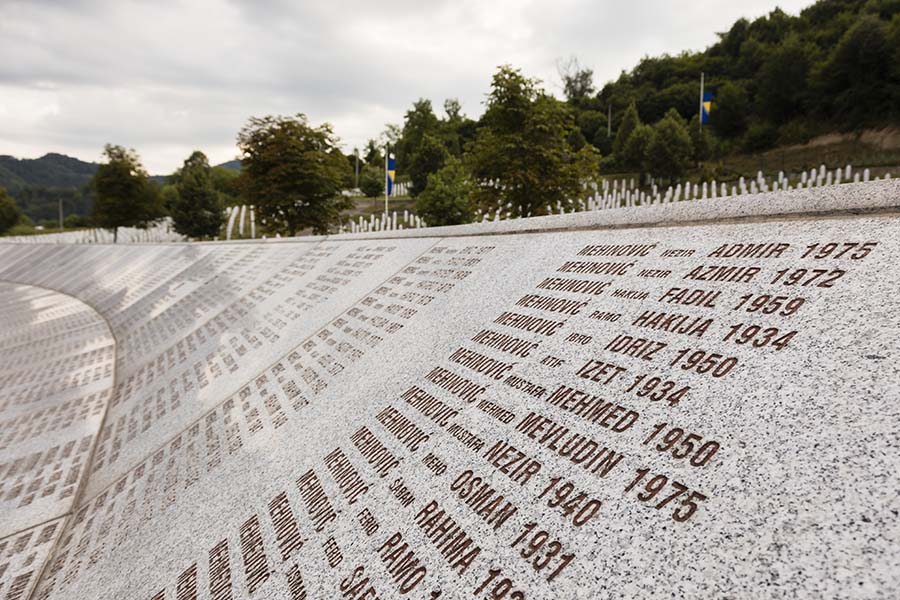
By Gareth Jonas, History and Political Science Alumnus
University of Birmingham
This year marks the twenty-third anniversary of the Srebrenica Genocide, described by the International Criminal Tribunal of Yugoslavia as “scenes from hell, written on the darkest pages of human history”. A seminal moment in international security, commemoration of this massacre is especially relevant for the ongoing discussion between academics and policy-makers on the future role of peacekeeping and responses to contemporary acts of ethnic cleansing* in areas such as Myanmar and Xinjiang.
The Genocide at Srebrenica
Srebrenica, an idyllic-looking town situated in eastern Bosnia-Hercegovina, is the scene of the largest act of genocide committed on European soil since 1945. It was here that 8,372 Bosniak (Bosnian-Muslim) men and boys were murdered by Bosnian-Serb paramilitary forces. This was considered an act of revenge by the Republika Srpska (VRS) troops against the Bosniak refugees’, ‘Turkish’ ancestors who had settled in the area (Bosnian Muslims are in fact ethnically Slavic).
Two years before the fall of Srebrenica, on 6th April 1993, the United Nations had declared the town and surrounding areas a ‘Safe Zone’: an area “free from any armed attack or any other hostile act”. To uphold this declaration, the UN instituted a small unit of peacekeepers as part of their United Nations Protection Force (UNPROFOR) peacekeeping mission. Between 1993 and 1995, these peacekeepers were poorly equipped, mandated and staffed. By the time the Bosnian-Serb forces overran the town, the peacekeepers gave no resistance. Their failure- alongside that of the international community – to intervene on behalf of the Bosniak refugees is an indelible stain on the historical record, testament to the severe shortcomings of UN peacekeeping and the global community’s ostensible commitment to peace, security and human rights.
(For a full timeline of the massacre click here.)
The impact of the past
The genocide at Srebrenica weighs heavily on contemporary Bosnia-Hercegovina. The country exists within a state of limbo, frozen in time as a consequence of the widespread trauma and suffering that continues to be felt by many. The effects of the conflict are still visible in the pockmarked buildings. Another- more telling- sign of the ethnic cleansing perpetrated by the VRS is the ethnic composition of the area. Although guaranteed the right of return, only a fraction of Bosnian-Muslim refugees have returned to the town.
To compound this trauma, many of the female survivors have yet to find the remains of their loved ones, and their suffering is immortalised in the name given to them by the media: ‘Mothers of Srebrenica’. The search for the bodily remains of the victims continues to this day through the work of the International Commission of Missing Persons (ICMP), an effort frustrated by the historic actions of VRS soldiers, who made a concerted effort to destroy the evidence of their crimes. So far, 6,504 victims have been buried at the memorial centre at Potočari. Every year, thousands of people gather at the cemetery on the 11th of July to bury the remains of their loved ones.
Contrary to what you may think, the genocide is not over. It continues to this day in the denial of the genocide by many Bosnian-Serb and Serbian citizens, media establishments and politicians. In 2010, the incumbent President of Republika Srspka stated in a media interview that “we cannot and will never accept qualifying that event as genocide”. Similarly, former Serbian president Tomislav Nikolic stated in 2012 that “there was no genocide in Srebrenica”. This view is widespread amongst citizens both of Republika Srpska and Serbia. Genocide denial, although occurring at every stage of the process, is the final stage of genocide. It serves to deny the humanity of the survivors and the legitimacy of their experience, preventing proper reconciliation and widening rifts which allow for the possible commitment of further atrocities. Acknowledgement of the genocide, and acceptance of responsibility, is one of many steps towards healing the rifts caused between communities by the war. Ultimately, it is necessary for peace.
* Described by the UN, ethnic cleansing is “rendering an area ethnically homogenous by using force or intimidation to remove persons of given groups from the area”
- Gareth Jonas visited Bosnia-Herzogovina last month as part of a commemorative delegation for the anti-hate charity Remembering Srebrenica.
- The views represented in this piece were made by the author and do not necessarily reflect the institutional views of the University of Birmingham or the Institute for Conflict, Cooperation and Security
- Back to Social Sciences Birmingham.
